Strategies for Mitigating Risks of Government-Led Energy Retrofitting Projects in China
Abstract
1. Introduction
2. Literature Review
2.1. Asset Specificity in Project Activities Related to Risks
2.2. Uncertainty of Project Activities Related to Risks
2.3. Frequency of Project Activities Related to Risks
3. Research Methodology
3.1. Questionnaire Survey Procedure and Sample Size
3.2. Variable Identification and Measurement
3.2.1. Behavioural Intentions towards the Risk-Related Project Activities
3.2.2. Asset Specificity
3.2.3. Environmental Uncertainty
3.2.4. Frequency
3.3. Data Analysis
3.3.1. Exploratory Factor Analysis (EFA)
3.3.2. Artificial Neural Network (ANN)
4. Results
4.1. Uncertainty Classification Based on EFA
4.2. Effects of TC-Related Factors Based on ANN
4.2.1. Effects of Asset Specificity
4.2.2. Effects of Environmental Uncertainty
4.2.3. Effects of Frequency
4.3. The Allocation of Risk Management Responsibility
5. Discussion
5.1. Dominant Role of Government Capability of Activity Execution in Risk Mitigation
5.2. Varying Roles of Environmental Uncertainty in Different Risks
5.2.1. Quality Objectives and Awareness of Responsibility Acting as Impetuses of Risk-Related Activities
5.2.2. Selective Execution of Risk-Related Activities under the Constraints of Costs and Time
5.2.3. Mature Retrofitting Market Contributing to Activity Execution Involving Various Parties
6. Conclusions and Policy Implications
- (1)
- The government should enhance the dissemination of information to ensure that homeowners have sufficient access to retrofitting information. The local government frequently fails to engage in communication with residents, resulting in a lack of cooperation among homeowners. Disseminating information on building retrofitting helps increase homeowners’ motivation to engage in energy retrofitting [56]. European governments have acknowledged that the internet, TV, and radio are effective instruments for disseminating information. In addition, China possesses a sophisticated mass media infrastructure that may be utilised to disseminate comprehensive information on retrofitting over an extended period of time. This includes regular public announcements through television and radio, as well as the creation of dedicated websites that focus on retrofitting operations, projects, and initiatives.
- (2)
- The government ought to execute retrofitting initiatives with enhanced transparency, particularly on technical and material specifications as well as professional qualifications. The most recent industry norm for energy-efficient retrofitting technologies in residential buildings in the HSCW zone of China was established in 2012. Implementing standardised technical specifications can be challenging, as technical solutions sometimes rely heavily on actual expertise gained from local retrofitting initiatives. In light of Italy and France’s successful sharing of energy-saving techniques and technology through the establishment of regional energy networks, the Chinese government should also prioritise similar technological exchanges to gain valuable experience in retrofitting technology. In addition, the reduction of technical risks primarily relies on the careful selection of personnel and materials, taking into account both the project and the market. In order to guarantee the precision and rationality of such selection, the government could promote material and staff certification and build databases for energy services. The certification system has evolved into a novel kind of governance aimed at regulating the market by providing incentives for specific types of conduct [86]. European techniques involve the creation of databases that provide information about companies and experts. These databases facilitate the selection of qualified professionals.
- (3)
- The government should prioritise the assessment of retrofitting quality through both ex-ante and ex-post evaluations. During project execution, the local government sometimes prioritises the quantity of finished projects rather than focusing on the quality and effectiveness of the retrofitting itself. Very few projects actually adhere to technical criteria when conducting energy-saving diagnoses. In such cases, the risk to the project arises from the subpar quality of the original structure. In addition, the number of completed projects is typically the main factor used to assess the achievement of retrofitting goals in China. The assessment standard for retrofitting is seldom used in practice due to its voluntary nature [56]. Greater emphasis should be placed on the energy-saving benefits that can be attained to encourage the implementation of the retrofit evaluation standard in practical settings.
- (4)
- The government should actively pursue further financial assistance for retrofitting initiatives. Financing diversification is a method of alleviating financial limitations. It is necessary to investigate other sources of funding for retrofitting projects rather than depending primarily on government budgetary allocations at all levels. The Chinese government may contemplate implementing further incentives to enhance owners’ inclination to participate in energy retrofitting, while also encouraging banking institutions to offer preferential financing services for such projects.
Author Contributions
Funding
Data Availability Statement
Acknowledgments
Conflicts of Interest
Appendix A
| Risk | Hidden Layers | RMSE | MAPE | ||
|---|---|---|---|---|---|
| Training | Testing | Training | Testing | ||
| R1 | 1 | 0.364 | 0.337 | 10.52% | 8.64% |
| 2 * | 0.350 | 0.340 | 10.05% | 8.77% | |
| R2 | 1 * | 0.399 | 0.398 | 11.33% | 11.12% |
| 2 | 0.440 | 0.439 | 12.85% | 10.98% | |
| R3 | 1 * | 0.337 | 0.337 | 9.24% | 8.52% |
| 2 | 0.426 | 0.418 | 12.24% | 5.65% | |
| R4 | 1 | 0.472 | 0.400 | 14.41% | 16.07% |
| 2 * | 0.461 | 0.346 | 14.27% | 13.31% | |
| R5 | 1 | 0.332 | 0.262 | 10.05% | 8.40% |
| 2 * | 0.311 | 0.272 | 9.06% | 8.77% | |
| R6 | 1 * | 0.386 | 0.385 | 11.15% | 10.37% |
| 2 | 0.397 | 0.396 | 10.61% | 11.99% | |
| R7 | 1 * | 0.378 | 0.336 | 13.28% | 14.25% |
| 2 | 0.397 | 0.335 | 14.63% | 13.54% | |
| R8 | 1 * | 0.438 | 0.437 | 12.73% | 11.81% |
| 2 | 0.519 | 0.516 | 16.68% | 9.16% | |
| R9 | 1 * | 0.479 | 0.481 | 12.13% | 10.74% |
| 2 | 0.518 | 0.520 | 15.67% | 13.37% | |
| R10 | 1 | 0.476 | 0.478 | 20.05% | 17.36% |
| 2 * | 0.471 | 0.482 | 18.89% | 15.57% | |
| R11 | 1 * | 0.506 | 0.514 | 14.51% | 13.21% |
| 2 | 0.524 | 0.544 | 16.97% | 13.98% | |
| R12 | 1 * | 0.500 | 0.477 | 16.56% | 15.81% |
| 2 | 0.527 | 0.571 | 19.19% | 15.26% | |
Appendix B. Effects of Three Top TC-Related Factors on Performing Project Activities Related to Each Risk
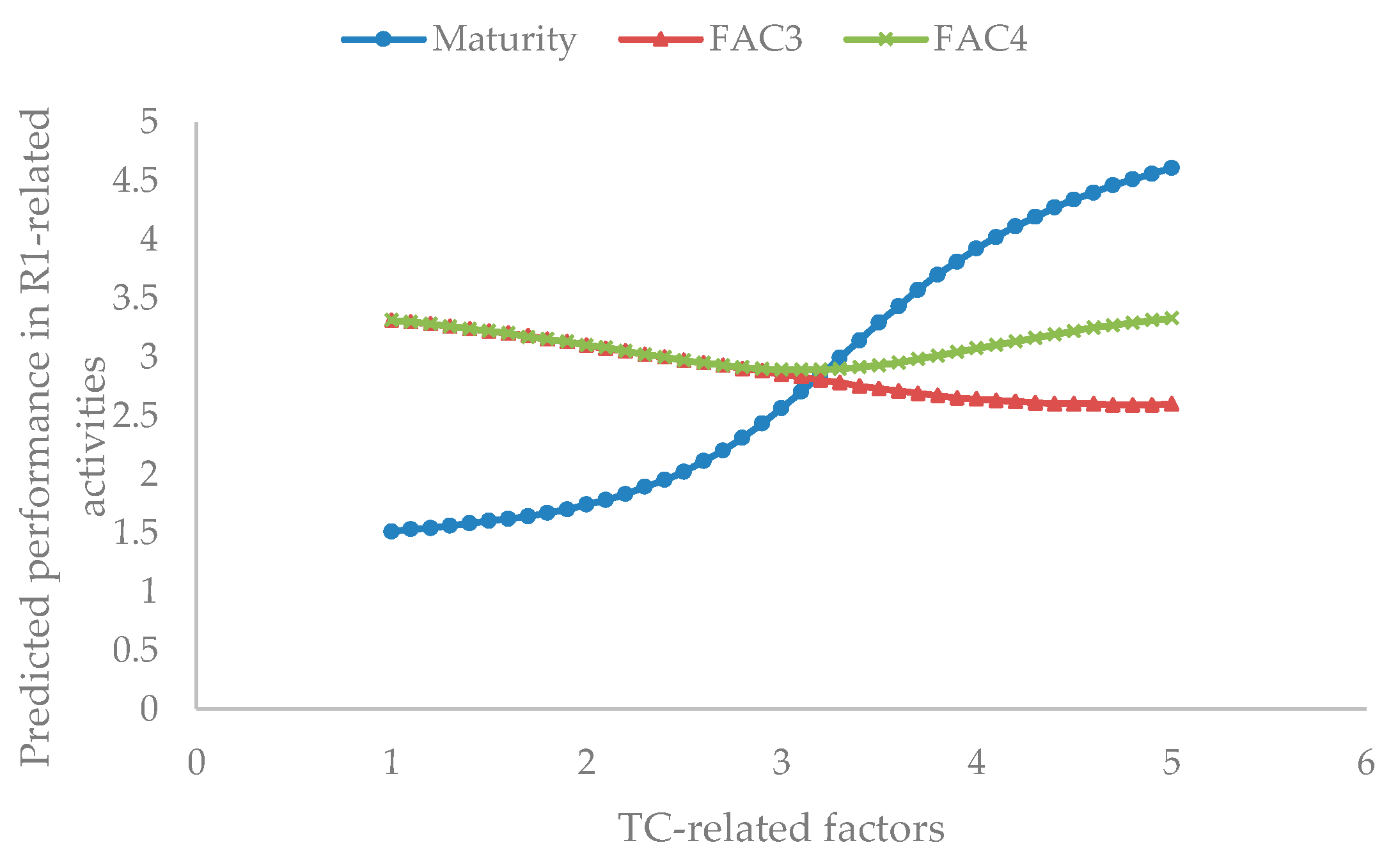

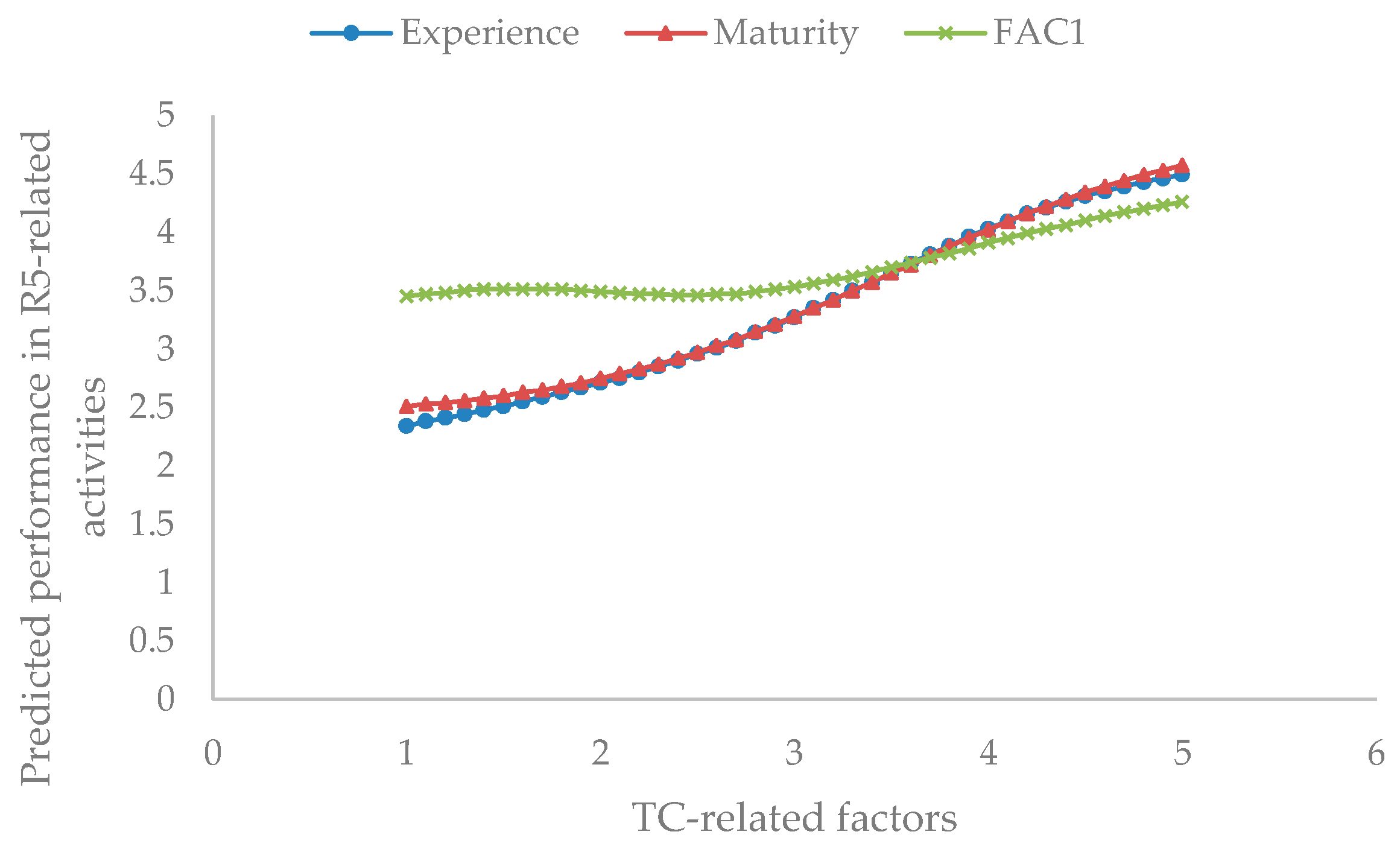
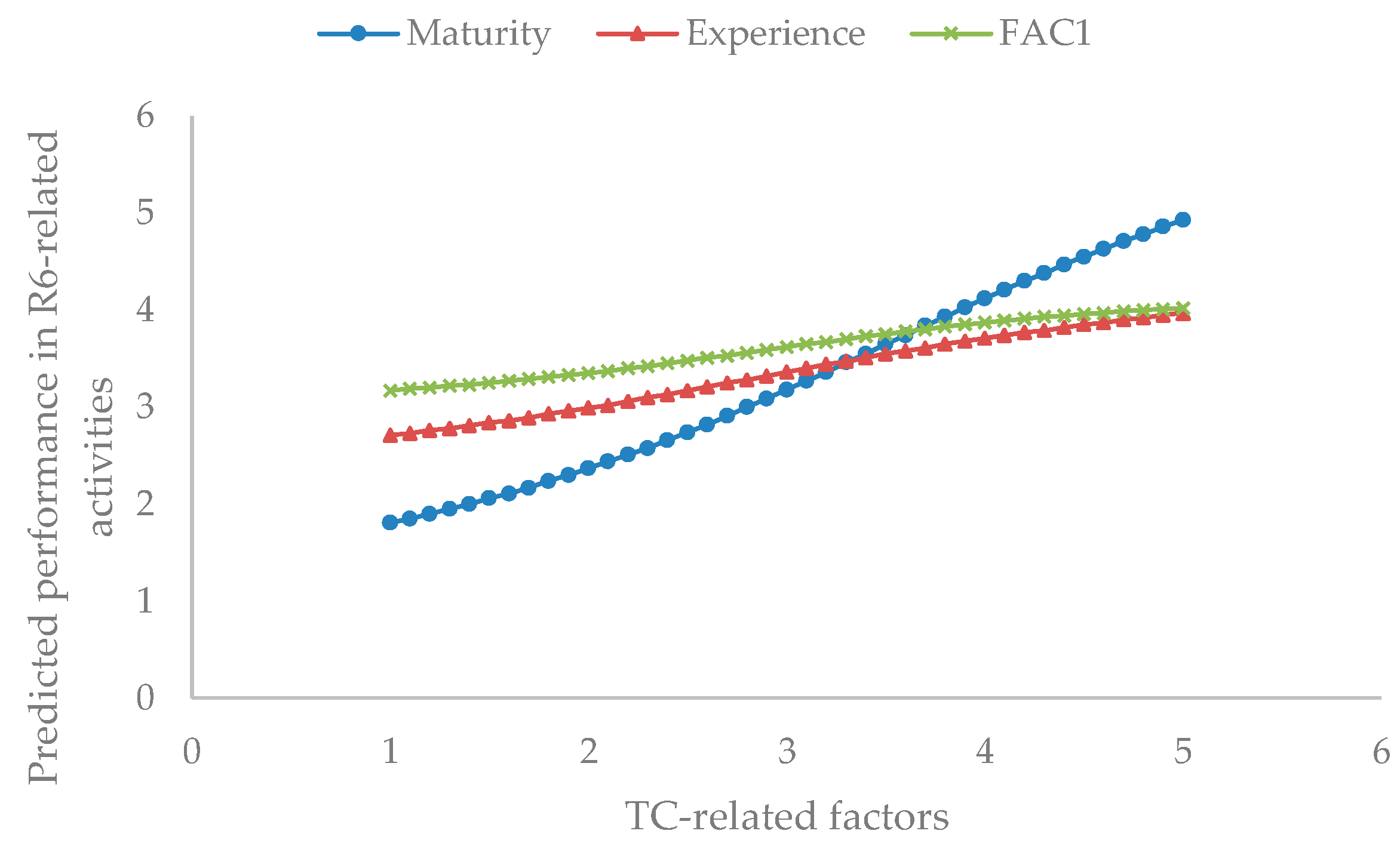
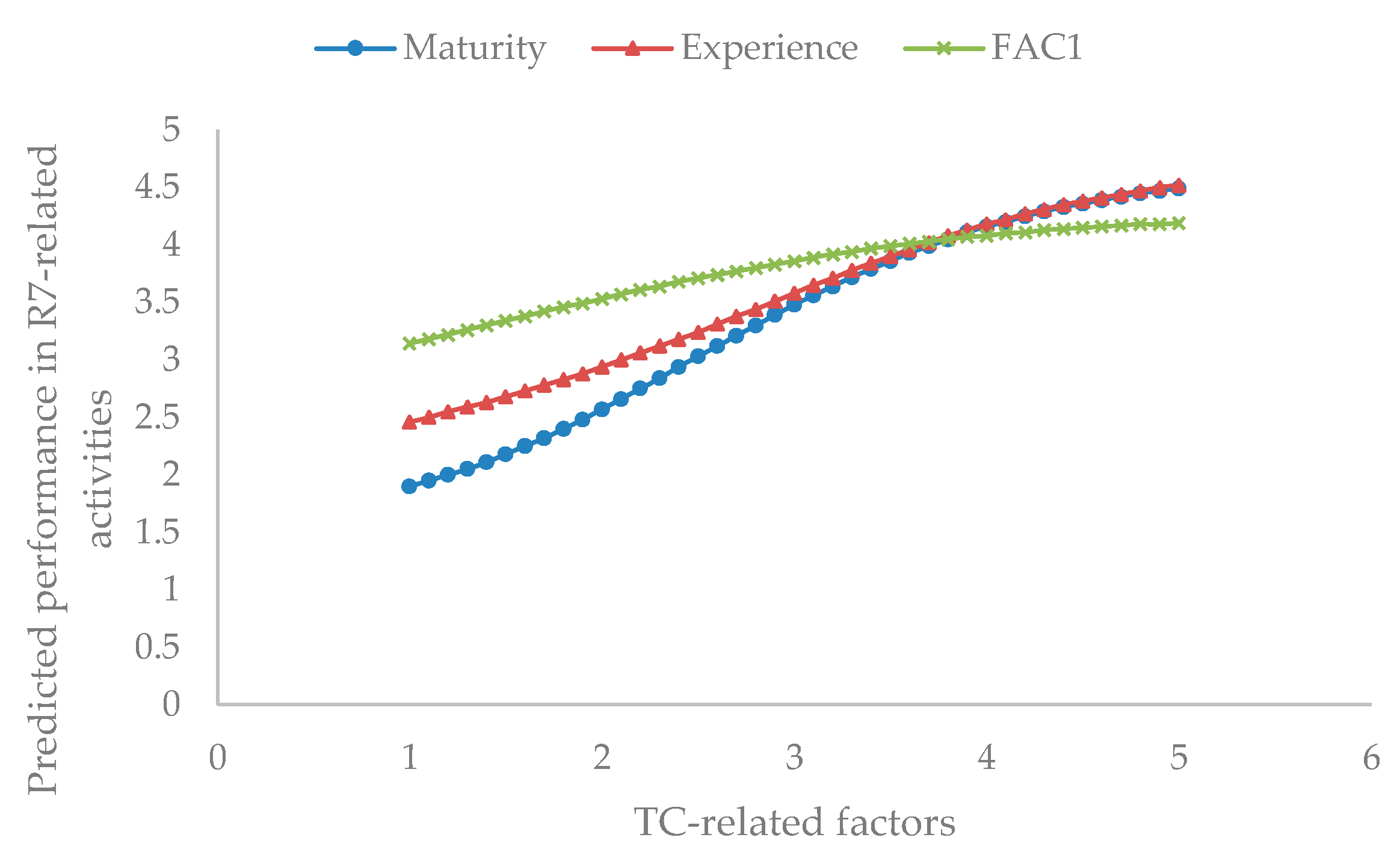
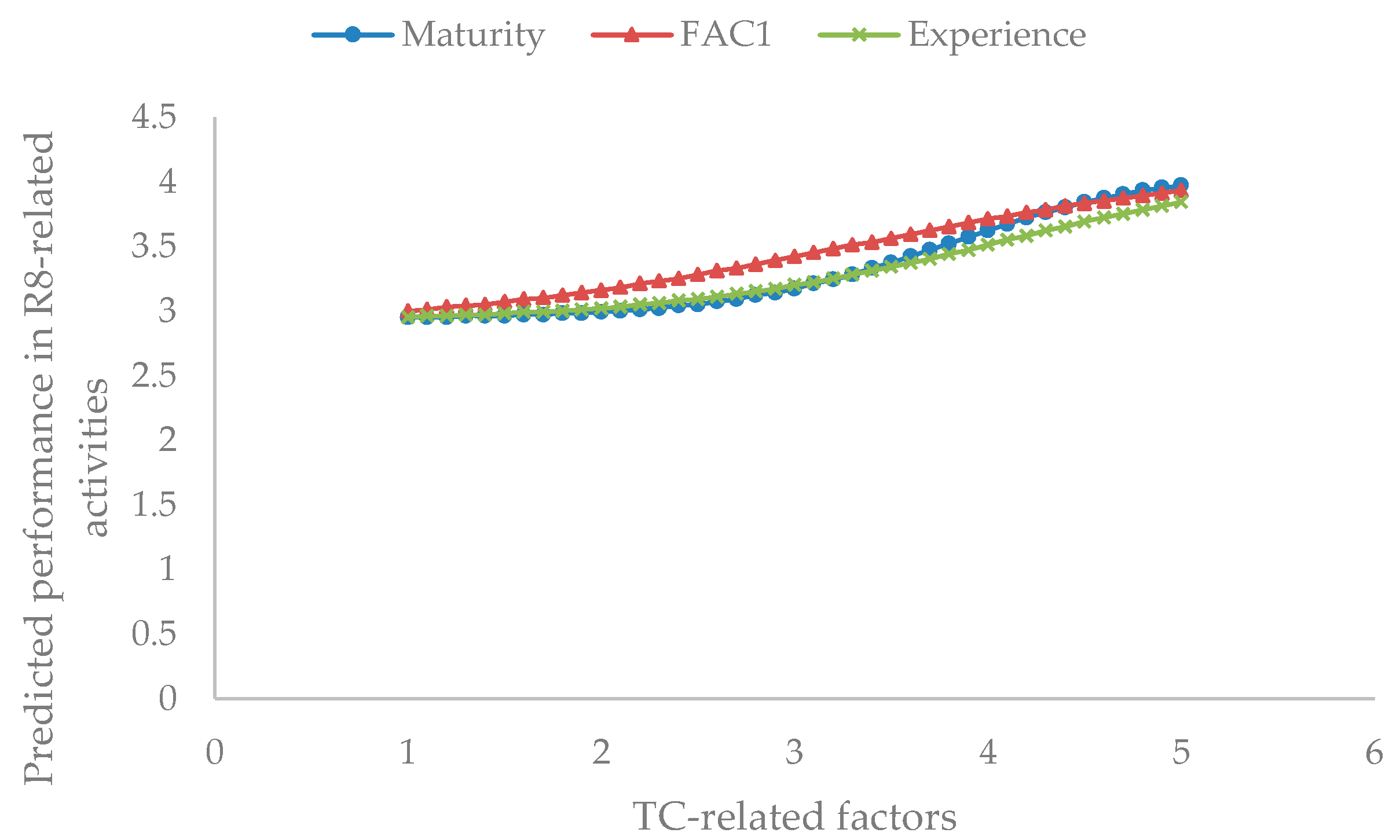
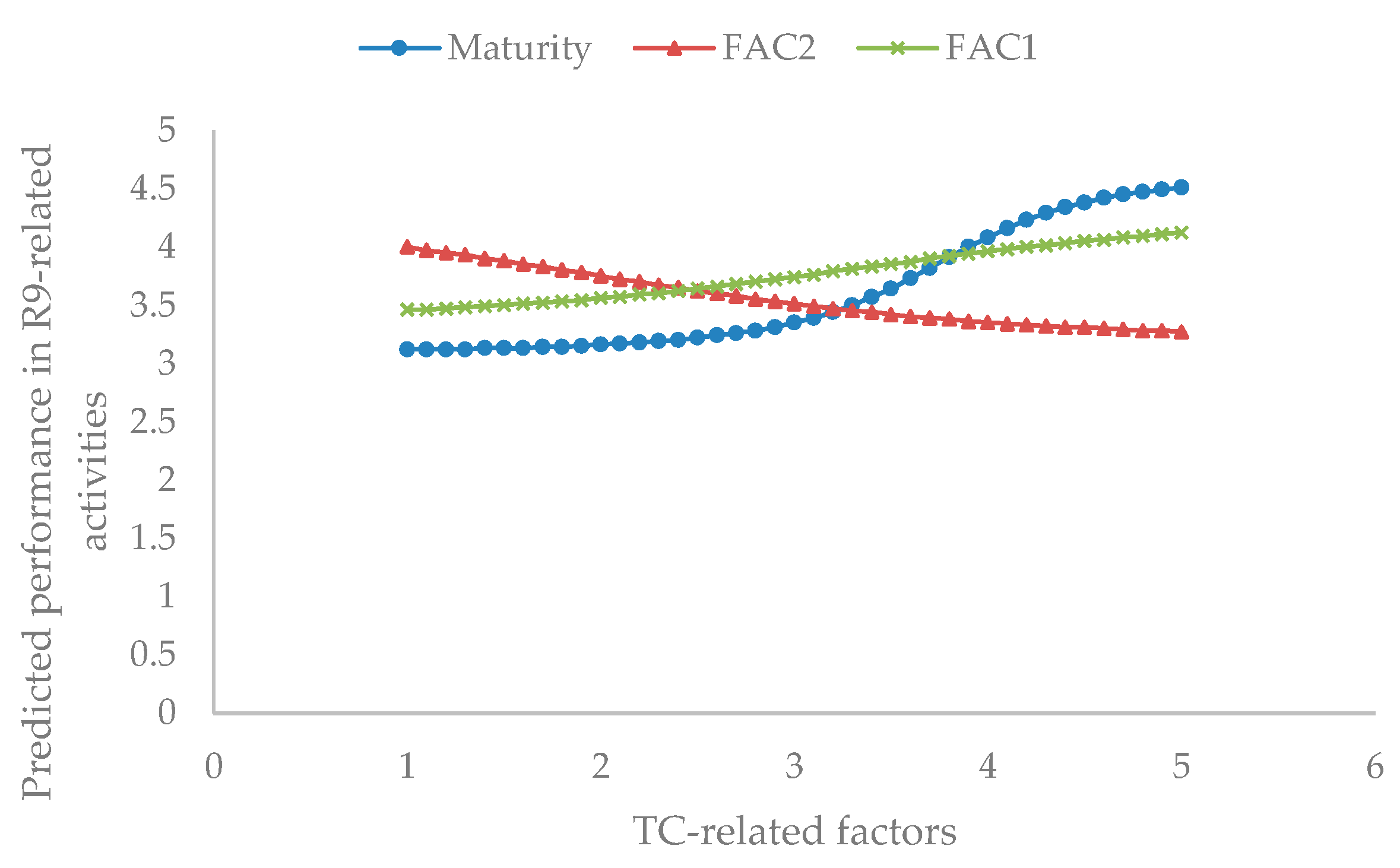
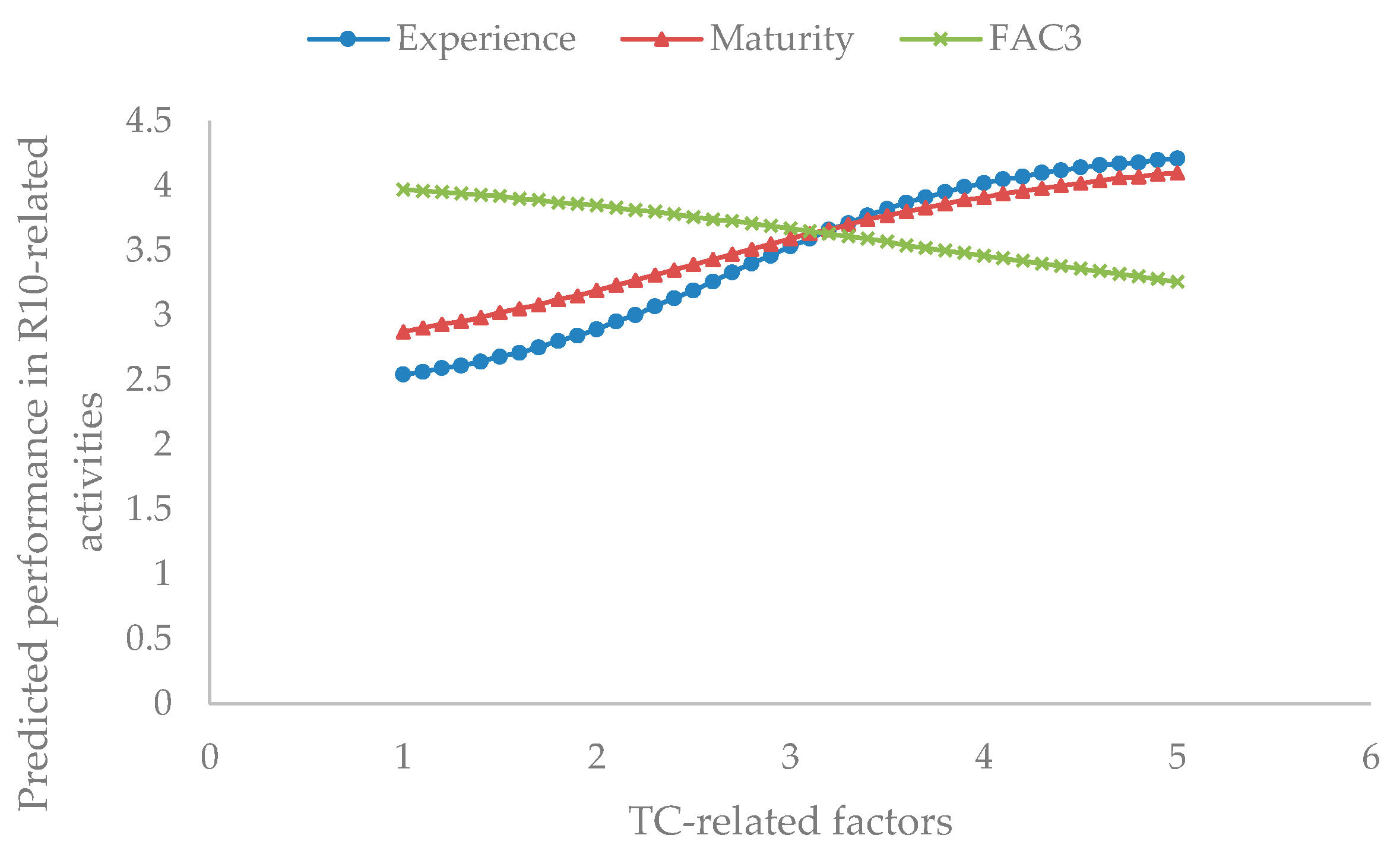
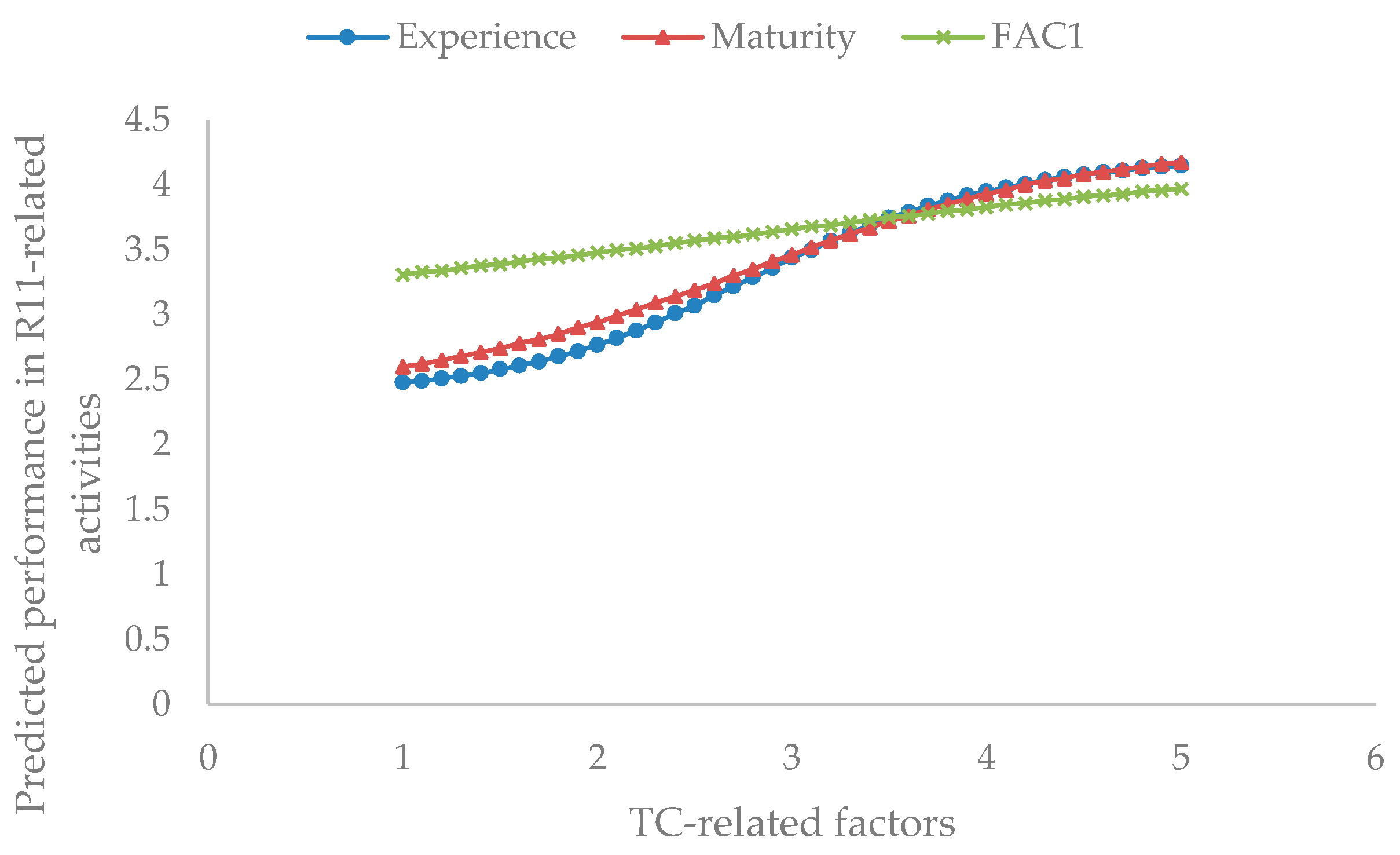
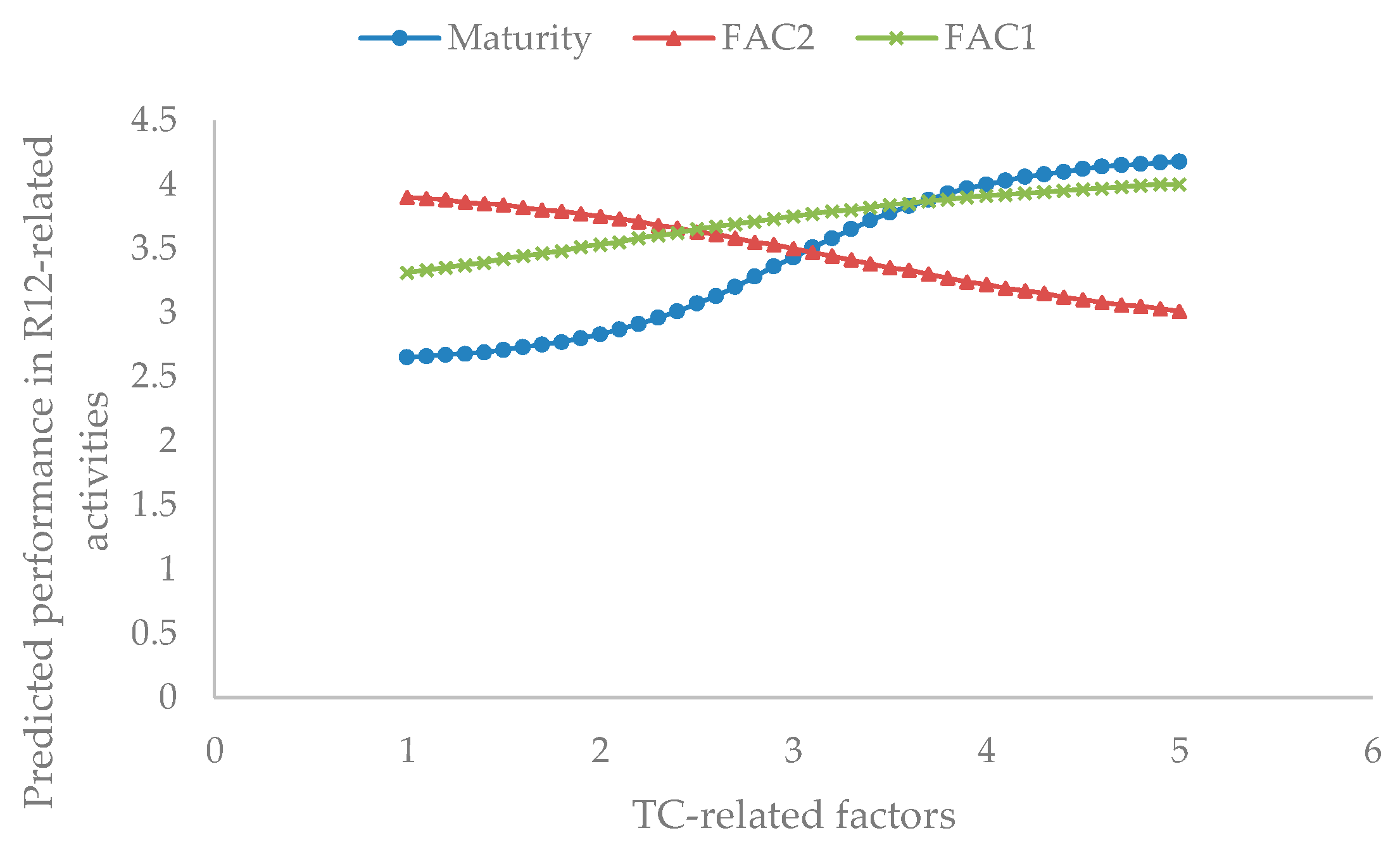
References
- Jia, L.; Qian, Q.K.; Meijer, F.; Visscher, H. Exploring key risks of energy retrofit of residential buildings in China with transaction cost considerations. J. Clean. Prod. 2021, 293, 126099. [Google Scholar] [CrossRef]
- Kiss, B. Exploring transaction costs in passive house-oriented retrofitting. J. Clean. Prod. 2016, 123, 65–76. [Google Scholar] [CrossRef]
- Liu, W.; Zhang, J.; Bluemling, B.; Mol, A.P.; Wang, C. Public participation in energy saving retrofitting of residential buildings in China. Appl. Energy 2015, 147, 287–296. [Google Scholar] [CrossRef]
- Wang, P.; Lu, Z.; Jia, L.; Yang, Y.; Huang, L. Optimal building retrofit pathways considering residential energy use variability: A case study of Nanjing city. Energy Build. 2023, 301, 113713. [Google Scholar] [CrossRef]
- Xia, N.; Wang, X.; Wang, Y.; Yang, Q.; Liu, X. Lifecycle cost risk analysis for infrastructure projects with modified Bayesian networks. J. Eng. Des. Technol. 2017, 15, 79–103. [Google Scholar] [CrossRef]
- Ouyang, J.; Lu, M.; Li, B.; Wang, C.; Hokao, K. Economic analysis of upgrading aging residential buildings in China based on dynamic energy consumption and energy price in a market economy. Energy Policy 2011, 39, 4902–4910. [Google Scholar] [CrossRef]
- Zhao, J.; Lou, F. Institutional effect analysis comparing energy efficiency retrofitting for existing residential buildings patterns in China. In Proceedings of the 1st Annual International Interdisciplinary Conference, Azores, Portugal, 24–26 April 2013. [Google Scholar]
- Bao, L.; Zhao, J.; Zhu, N. Analysis and proposal of implementation effects of heat metering and energy efficiency retrofit of existing residential buildings in northern heating areas of China in “the 11th Five-Year Plan” period. Energy Policy 2012, 45, 521–528. [Google Scholar] [CrossRef]
- Biekša, D.; Šiupšinskas, G.; Martinaitis, V.; Jaraminienė, E. Energy efficiency challenges in multi-apartment building renovation in Lithuania. J. Civ. Eng. Manag. 2011, 17, 467–475. [Google Scholar] [CrossRef]
- Caputo, P.; Pasetti, G. Overcoming the inertia of building energy retrofit at municipal level: The Italian challenge. Sustain. Cities Soc. 2015, 15, 120–134. [Google Scholar] [CrossRef]
- Dahlhausen, M.; Heidarinejad, M.; Srebric, J. Building energy retrofits under capital constraints and greenhouse gas pricing scenarios. Energy Build. 2015, 107, 407–416. [Google Scholar] [CrossRef]
- Li, D. Fiscal and tax policy support for energy efficiency retrofit for existing residential buildings in China’s northern heating region. Energy Policy 2009, 37, 2113–2118. [Google Scholar] [CrossRef]
- Lo, K. The “Warm Houses” program: Insulating existing buildings through compulsory retrofits. Sustain. Energy Technol. Assess. 2015, 9, 63–67. [Google Scholar] [CrossRef]
- Mills, E. Risk transfer via energy-savings insurance. Energy Policy 2003, 31, 273–281. [Google Scholar] [CrossRef]
- Mills, E.; Kromer, S.; Weiss, G.; Mathew, P.A. From volatility to value: Analysing and managing financial and performance risk in energy savings projects. Energy Policy 2006, 34, 188–199. [Google Scholar] [CrossRef]
- Alam, M.; Zou, P.X.; Stewart, R.A.; Bertone, E.; Sahin, O.; Buntine, C.; Marshall, C. Government championed strategies to overcome the barriers to public building energy efficiency retrofit projects. Sustain. Cities Soc. 2019, 44, 56–69. [Google Scholar] [CrossRef]
- Pardo-Bosch, F.; Cervera, C.; Ysa, T. Key aspects of building retrofitting: Strategizing sustainable cities. J. Environ. Manag. 2019, 248, 109247. [Google Scholar] [CrossRef] [PubMed]
- Cai, W.; Wu, Y.; Zhong, Y.; Ren, H. China building energy consumption: Situation, challenges and corresponding measures. Energy Policy 2009, 37, 2054–2059. [Google Scholar] [CrossRef]
- Friedman, C.; Becker, N.; Erell, E. Energy retrofit of residential building envelopes in Israel: A cost-benefit analysis. Energy 2014, 77, 183–193. [Google Scholar] [CrossRef]
- Shaikh, P.; Shaikh, F.; Sahito, A.; Uqaili, M.; Umrani, Z. An Overview of the Challenges for Cost-Effective and Energy-Efficient Retrofits of the Existing Building Stock. In Cost-Effective Energy Efficient Building Retrofitting; Pacheco-Torgal, F., Granqvist, C.-G., Jelle, B.P., Vanoli, G.P., Bianco, N., Kurnitski, J., Eds.; Elsevier: Amsterdam, The Netherlands, 2017; pp. 257–278. [Google Scholar] [CrossRef]
- Krarti, M.; Dubey, K.; Howarth, N. Evaluation of building energy efficiency investment options for the Kingdom of Saudi Arabia. Energy 2017, 134, 595–610. [Google Scholar] [CrossRef]
- Mikulić, D.; Bakarić, I.R.; Slijepčević, S. The economic impact of energy saving retrofits of residential and public buildings in Croatia. Energy Policy 2016, 96, 630–644. [Google Scholar] [CrossRef]
- He, Q.; Zhao, H.; Shen, L.; Dong, L.; Cheng, Y.; Xu, K. Factors Influencing Residents’ Intention toward Green Retrofitting of Existing Residential Buildings. Sustainability 2019, 11, 4246. [Google Scholar] [CrossRef]
- Palmer, K.; Walls, M.; Gordon, H.; Gerarden, T. Assessing the energy-efficiency information gap: Results from a survey of home energy auditors. Energy Effic. 2013, 6, 271–292. [Google Scholar] [CrossRef]
- Dittfeld, H.; Scholten, K.; Van Donk, D.P. Proactively and reactively managing risks through sales & operations planning. Int. J. Phys. Distrib. Logist. Manag. 2021, 51, 566–584. [Google Scholar] [CrossRef]
- Can Saglam, Y.; Yildiz Çankaya, S.; Sezen, B. Proactive risk mitigation strategies and supply chain risk management performance: An empirical analysis for manufacturing firms in Turkey. J. Manuf. Technol. Manag. 2021, 32, 1224–1244. [Google Scholar] [CrossRef]
- Giannakis, M.; Papadopoulos, T. Supply chain sustainability: A risk management approach. Int. J. Prod. Econ. 2016, 171, 455–470. [Google Scholar] [CrossRef]
- Rajesh, R.; Ravi, V. Modeling enablers of supply chain risk mitigation in electronic supply: A Grey–DEMATEL approach. Comput. Ind. Eng. 2015, 87, 126–139. [Google Scholar] [CrossRef]
- Xia, N.; Zou, P.X.; Griffin, M.A.; Wang, X.; Zhong, R. Towards integrating construction risk management and stakeholder management: A systematic literature review and future research agendas. Int. J. Proj. Manag. 2018, 36, 701–715. [Google Scholar] [CrossRef]
- Kerzner, H. Project Management Best Practices: Achieving Global Excellence; John Wiley & Sons: Hoboken, NJ, USA, 2018. [Google Scholar]
- Haaskjold, H.; Andersen, B.; Lædre, O.; Aarseth, W. Factors affecting transaction costs and collaboration in projects. Int. J. Manag. Proj. Bus. 2020, 13, 197–230. [Google Scholar] [CrossRef]
- Yan, D.; Zhe, T.; Yong, W.; Neng, Z. Achievements and suggestions of heat metering and energy efficiency retrofit for existing residential buildings in northern heating regions of China. Energy Policy 2011, 39, 4675–4682. [Google Scholar] [CrossRef]
- Nolan, C.; Trew, A. Transaction costs and institutions: Investments in exchange. BE J. Theor. Econ. 2015, 15, 391–432. [Google Scholar] [CrossRef]
- Williamson, O.E. Transaction cost economics: How it works; where it is headed. Economist 1998, 146, 23–58. [Google Scholar] [CrossRef]
- Williamson, O.E. The economics of governance. Am. Econ. Rev. 2005, 95, 1–18. [Google Scholar] [CrossRef]
- Williamson, O.E. Outsourcing: Transaction cost economics and supply chain management. J. Supply Chain Manag. 2008, 44, 5–16. [Google Scholar] [CrossRef]
- Williamson, O.E. The Mechanisms of Governance; Oxford University Press: Oxford, UK, 1996. [Google Scholar]
- Wilson, C.; Grubler, A.; Bento, N.; Healey, S.; De Stercke, S.; Zimm, C. Granular technologies to accelerate decarbonization. Science 2020, 368, 36–39. [Google Scholar] [CrossRef] [PubMed]
- McIvor, R.; Bals, L. A multi-theory framework for understanding the reshoring decision. Int. Bus. Rev. 2021, 30, 101827. [Google Scholar] [CrossRef]
- Catanzaro, A.; Teyssier, C. Export promotion programs, export capabilities, and risk management practices of internationalized SMEs. Small Bus. Econ. 2021, 57, 1479–1503. [Google Scholar] [CrossRef]
- Cuypers, I.R.; Hennart, J.F.; Silverman, B.S.; Ertug, G. Transaction cost theory: Past progress, current challenges, and suggestions for the future. Acad. Manag. Ann. 2021, 15, 111–150. [Google Scholar] [CrossRef]
- Huang, S.Z.; Chau, K.Y.; Chien, F.; Shen, H. The impact of startups’ dual learning on their green innovation capability: The effects of business executives’ environmental awareness and environmental regulations. Sustainability 2020, 12, 6526. [Google Scholar] [CrossRef]
- Dandage, R.V.; Mantha, S.S.; Rane, S.B.; Bhoola, V. Analysis of interactions among barriers in project risk management. J. Ind. Eng. Int. 2018, b14, 153–169. [Google Scholar] [CrossRef]
- Hwang, B.-G.; Zhao, X.; Toh, L.P. Risk management in small construction projects in Singapore: Status, barriers and impact. Int. J. Proj. Manag. 2014, 32, 116–124. [Google Scholar] [CrossRef]
- Rasheed, S.; ChangFeng, W.; Yaqub, F. Towards program risk management and perceived risk management barriers. Int. J. Hybrid Inf. Technol. 2015, 8, 323–338. [Google Scholar] [CrossRef]
- Rostami, A.; Sommerville, J.; Wong, L.; Lee, C. Risk management implementation in small and medium enterprises in the UK construction industry. Eng. Constr. Archit. Manag. 2015, 22, 91–107. [Google Scholar] [CrossRef]
- Tang, W.; Qiang, M.; Duffield, C.F.; Young, D.M.; Lu, Y. Risk management in the Chinese construction industry. J. Constr. Eng. Manag. 2007, 133, 944–956. [Google Scholar] [CrossRef]
- Naughton, S.; Golgeci, I.; Arslan, A. Supply chain agility as an acclimatisation process to environmental uncertainty and organisational vulnerabilities: Insights from British SMEs. Prod. Plan. Control 2020, 31, 1164–1177. [Google Scholar] [CrossRef]
- Yang, Q.; Zhao, X. Are logistics outsourcing partners more integrated in a more volatile environment? Int. J. Prod. Econ. 2016, 171, 211–220. [Google Scholar] [CrossRef]
- De Feijter, F.J.; van Vliet, B.J.; Chen, Y. Household inclusion in the governance of housing retrofitting: Analysing Chinese and Dutch systems of energy retrofit provision. Energy Res. Soc. Sci. 2019, 53, 10–22. [Google Scholar] [CrossRef]
- Galatioto, A.; Ciulla, G.; Ricciu, R. An overview of energy retrofit actions feasibility on Italian historical buildings. Energy 2017, 137, 991–1000. [Google Scholar] [CrossRef]
- Vullo, P.; Passera, A.; Lollini, R.; Prada, A.; Gasparella, A. Implementation of a multi-criteria and performance-based procurement procedure for energy retrofitting of facades during early design. Sustain. Cities Soc. 2018, 36, 363–377. [Google Scholar] [CrossRef]
- Shao, Y.; Geyer, P.; Lang, W. Integrating requirement analysis and multi-objective optimization for office building energy retrofit strategies. Energy Build. 2014, 82, 356–368. [Google Scholar] [CrossRef]
- Killip, G.; Owen, A.; Topouzi, M. Exploring the practices and roles of UK construction manufacturers and merchants in relation to housing energy retrofit. J. Clean. Prod. 2020, 251, 119205. [Google Scholar] [CrossRef]
- Fylan, F.; Glew, D.; Smith, M.; Johnston, D.; Brooke-Peat, M.; Miles-Shenton, D.; Fletcher, M.; Aloise-Young, P.; Gorse, C. Reflections on retrofits: Overcoming barriers to energy efficiency among the fuel poor in the United Kingdom. Energy Res. Soc. Sci. 2016, 21, 190–198. [Google Scholar] [CrossRef]
- Liu, G.; Li, X.; Tan, Y.; Zhang, G. Building green retrofit in China: Policies, barriers and recommendations. Energy Policy 2020, 139, 111356. [Google Scholar] [CrossRef]
- Wang, B.; Xia, X. Optimal maintenance planning for building energy efficiency retrofitting from optimization and control system perspectives. Energy Build. 2015, 96, 299–308. [Google Scholar] [CrossRef]
- McCann, L. Transaction costs and environmental policy design. Ecol. Econ. 2013, 88, 253–262. [Google Scholar] [CrossRef]
- Williamson, O. The Economic Institutions of Capitalism; Free Press: New York, NY, USA, 1985. [Google Scholar]
- Wong, C.W.; Lirn, T.C.; Yang, C.C.; Shang, K.C. Supply chain and external conditions under which supply chain resilience pays: An organizational information processing theorization. Int. J. Prod. Econ. 2020, 226, 107610. [Google Scholar] [CrossRef]
- Huo, B.; Ye, Y.; Zhao, X.; Wei, J.; Hua, Z. Environmental uncertainty, specific assets, and opportunism in 3PL relationships: A transaction cost economics perspective. Int. J. Prod. Econ. 2018, 203, 154–163. [Google Scholar] [CrossRef]
- Jin, X.-H. Determinants of efficient risk allocation in privately financed public infrastructure projects in Australia. J. Constr. Eng. Manag. 2010, 136, 138–150. [Google Scholar] [CrossRef]
- Wang, Q.C.; Ren, Y.T.; Liu, X.; Chang, R.D.; Zuo, J. Exploring the heterogeneity in drivers of energy-saving behaviours among hotel guests: Insights from the theory of planned behaviour and personality profiles. Environ. Impact Assess. Rev. 2023, 99, 107012. [Google Scholar] [CrossRef]
- Tan, Y.; Ying, X.; Gao, W.; Wang, S.; Liu, Z. Applying an extended theory of planned behavior to predict willingness to pay for green and low-carbon energy transition. J. Clean. Prod. 2023, 387, 135893. [Google Scholar] [CrossRef]
- Liu, Z.; Yu, C.; Qian, Q.K.; Huang, R.; You, K.; Visscher, H.; Zhang, G. Incentive initiatives on energy-efficient renovation of existing buildings towards carbon-neutral blueprints in China: Advancements, challenges and perspectives. Energy Build. 2023, 296, 113343. [Google Scholar] [CrossRef]
- Jia, L.; Qian, Q.K.; Meijer, F.; Visscher, H. Stakeholders’ Risk Perception: A Perspective for Proactive Risk Management in Residential Building Energy Retrofits in China. Sustainability 2020, 12, 2832. [Google Scholar] [CrossRef]
- Emami-Naeini, P.; Dheenadhayalan, J.; Agarwal, Y.; Cranor, L.F. Which privacy and security attributes most impact consumers’ risk perception and willingness to purchase IoT devices? In Proceedings of the IEEE Symposium on Security and Privacy (SP), San Francisco, CA, USA, 24–27 May 2021; pp. 519–536. [Google Scholar] [CrossRef]
- Hanea, A.M.; Hemming, V.; Nane, G.F. Uncertainty quantification with experts: Present status and research needs. Risk Analysis 2022, 42, 254–263. [Google Scholar] [CrossRef] [PubMed]
- Slovic, P. Perception of risk. Science 1987, 236, 280–285. [Google Scholar] [CrossRef] [PubMed]
- Bickerstaff, K. Risk perception research: Socio-cultural perspectives on the public experience of air pollution. Environ. Int. 2004, 30, 827–840. [Google Scholar] [CrossRef] [PubMed]
- Jin, X.H.; Doloi, H. Interpreting risk allocation mechanism in public–private partnership projects: An empirical study in a transaction cost economics perspective. Constr. Manag. Econ. 2008, 26, 707–721. [Google Scholar] [CrossRef]
- Hew, T.S.; Leong, L.Y.; Ooi, K.B.; Chong, A.Y.L. Predicting drivers of mobile entertainment adoption: A two-stage SEM-artificial-neural-network analysis. J. Comput. Inf. Syst. 2016, 56, 352–370. [Google Scholar] [CrossRef]
- Priyadarshinee, P.; Raut, R.D.; Jha, M.K.; Gardas, B.B. Understanding and predicting the determinants of cloud computing adoption: A two staged hybrid SEM-Neural networks approach. Comput. Hum. Behav. 2017, 76, 341–362. [Google Scholar] [CrossRef]
- Suzuki, K. (Ed.) Artificial Neural Networks-Methodological Advances and Biomedical Applications; InTech: Houston, TX, USA, 2011. [Google Scholar]
- Tavşancıl, E. Measuring attitudes and data analysis with SPSS. In Tutumların Ölçülmesi ve spss ile Veri Analizi; Nobel Yayınları: Ankara, Turkey, 2014. [Google Scholar]
- Elsheikh, A.H.; Sharshir, S.W.; Abd Elaziz, M.; Kabeel, A.; Guilan, W.; Haiou, Z. Modeling of solar energy systems using artificial neural network: A comprehensive review. Sol. Energy 2019, 180, 622–639. [Google Scholar] [CrossRef]
- Talwar, S.; Srivastava, S.; Sakashita, M.; Islam, N.; Dhir, A. Personality and travel intentions during and after the COVID-19 pandemic: An artificial neural network (ANN) approach. J. Bus. Res. 2022, 142, 400–411. [Google Scholar] [CrossRef]
- Talwar, S.; Talwar, M.; Tarjanne, V.; Dhir, A. Why retail investors traded equity during the pandemic? An application of artificial neural networks to examine behavioral biases. Psychol. Mark. 2021, 38, 2142–2163. [Google Scholar] [CrossRef]
- Li, J.; Shui, B. A comprehensive analysis of building energy efficiency policies in China: Status quo and development perspective. J. Clean. Prod. 2015, 90, 326–344. [Google Scholar] [CrossRef]
- Basu, R. Managing quality in projects: An empirical study. Int. J. Proj. Manag. 2014, 32, 178–187. [Google Scholar] [CrossRef]
- Younis, K.M. Views on potential methods for raising environmental awareness in developing countries: A study on social responsibility engagement in Liberia. Glob. Bioeth. 2015, 26, 128–144. [Google Scholar] [CrossRef]
- SBQTS. Stage Division and Code of Procedure for Development of National Standards; Standards Press of China: Beijing, China, 1997. [Google Scholar]
- Wachinger, G.; Renn, O.; Begg, C.; Kuhlicke, C. The risk perception paradox—Implications for governance and communication of natural hazards. Risk Anal. 2013, 33, 1049–1065. [Google Scholar] [CrossRef] [PubMed]
- Yin, S.; Li, B.; Xing, Z. The governance mechanism of the building material industry (BMI) in transformation to green BMI: The perspective of green building. Sci. Total Environ. 2019, 677, 19–33. [Google Scholar] [CrossRef]
- Wu, Y.; Huang, Y.; Zhang, S.; Zhang, Y. Quality self-control and co-supervision mechanism of construction agent in public investment project in China. Habitat Int. 2012, 36, 471–480. [Google Scholar] [CrossRef]
- Meidinger, E.; Elliott, C.; Oesten, G. Social and Political Dimensions of Forest Certification. ed. by Errol Meidinger, Chris Elliott, Gerhard Oesten; Remagen-Oberwinter, 2003, SUNY Buffalo Legal Studies Research Paper No. 2015-007. Available online: https://ssrn.com/abstract=2539803 (accessed on 1 December 2020).

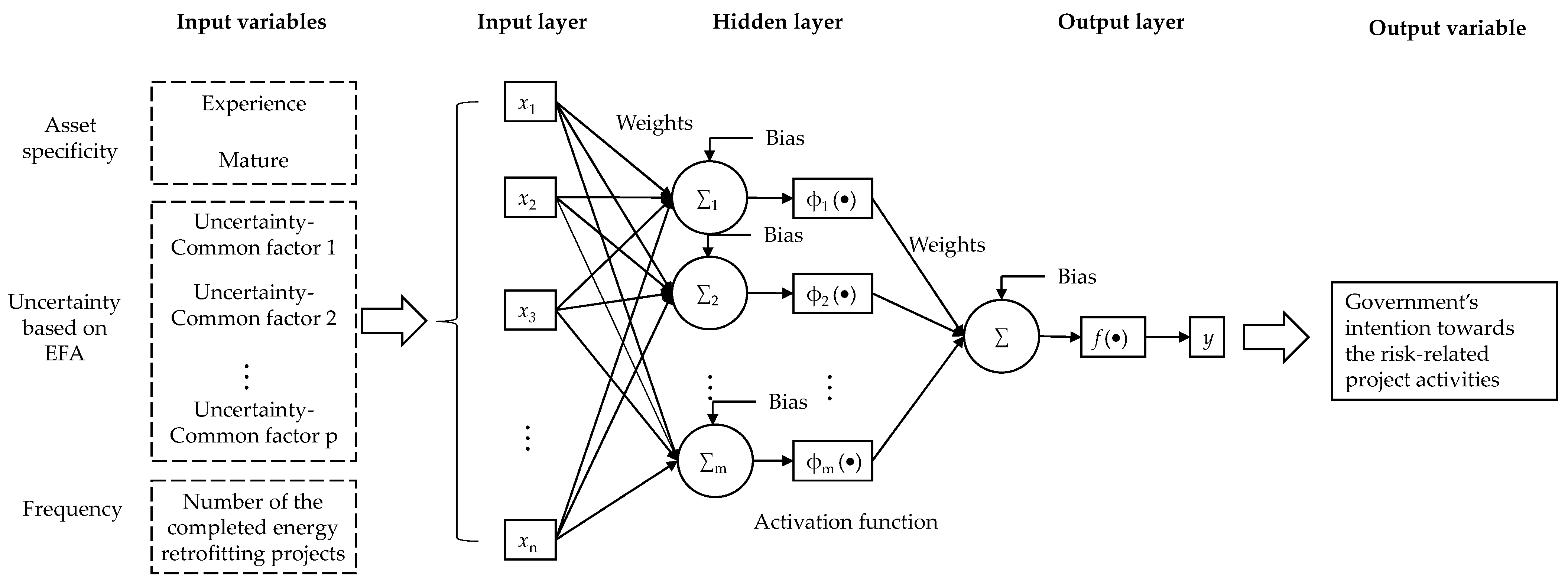

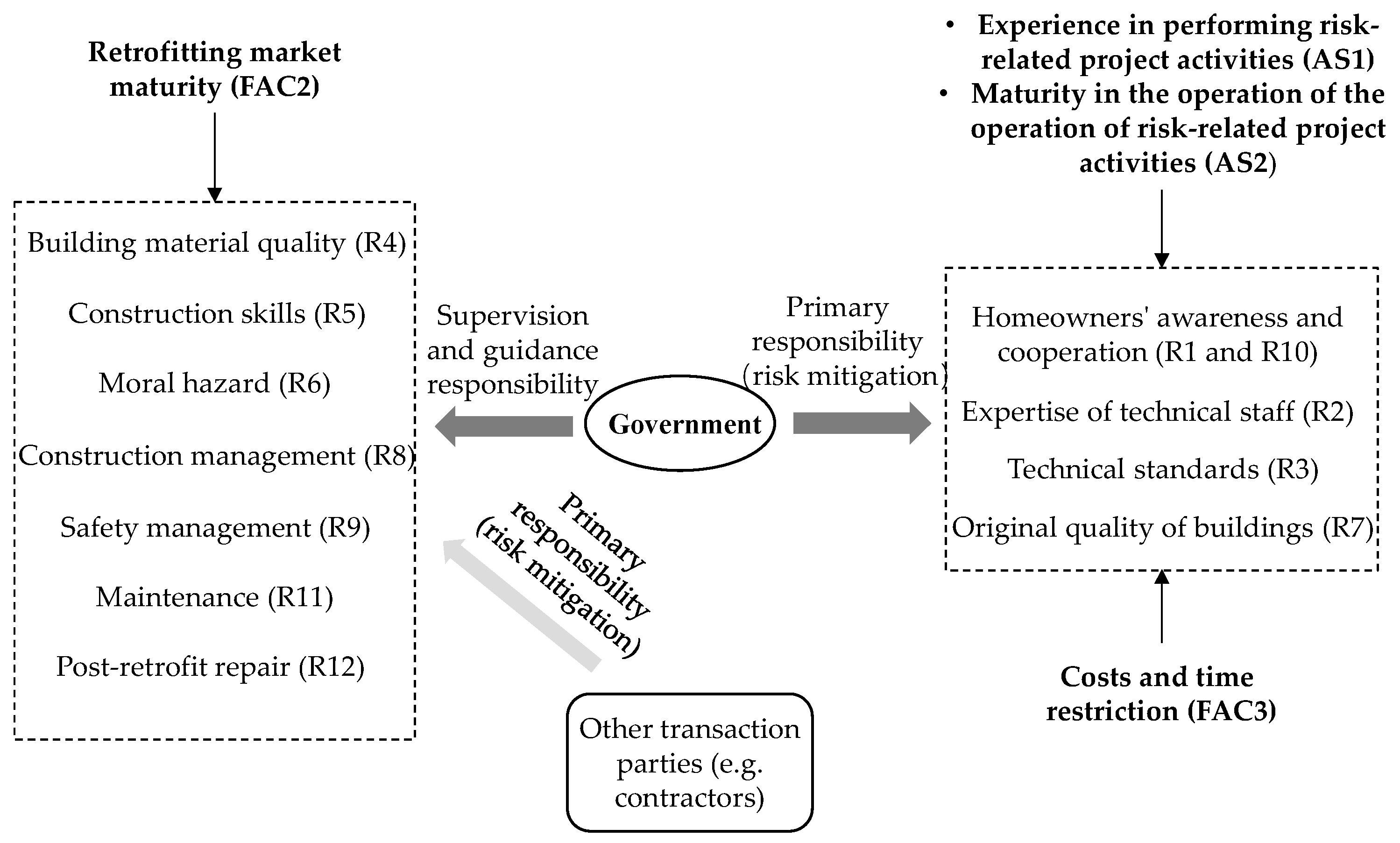
| Types | Barriers to Risk Management Implementation | TC-Related Barriers to Risk-Related Activities (by Authors) |
|---|---|---|
| Lack of learning/training | Lack of formal training to understand risk management | Asset specificity-Maturity in the operation of risk-related project activities |
| Shortage of knowledge/techniques on risk management | ||
| Resistance to learning something new | ||
| Divergence of strategies | Lack of top management support | Uncertainty-U1: Resistance of other cooperation units U2: Resistance of the residential community |
| Lack of consistency in risk control strategies | ||
| Inappropriate risk allocation | ||
| Information insufficiency | Resistance to talking about risks | Uncertainty-U3: Design complexity U4: Construction complexity |
| Insufficient risk and project information | ||
| Contextual restrictions | Lack of organisational culture for risk consciousness | Uncertainty-U5: Stability of supportive policies |
| Conflicts among different functions | ||
| Unstable organisational environment | ||
| Low degree of mandatory risk management | ||
| Ineffective monitoring | ||
| Lack of government legislation | ||
| Resource constraints | Time constraints | Uncertainty-U6: Urgency of energy retrofitting missions U7: Rigidity of limited time and costs |
| Cost and budget constraints | ||
| Shortage of experienced and skilled professionals | Asset specificity-Experience in performing risk-related project activities |
| Stage | Retrofitting Work with Uncertainty | Environmental Uncertainty from a TCs Perspective (by Authors) |
|---|---|---|
| Regional survey and project setup | Making an agreement with homeowners for retrofitting [50] | U8: Integrity of agreement provision |
| Evaluation and measurement of retrofitting feasibility [51] | U9: Competence of experts for safety appraisal of buildings | |
| U10: Detectability of building quality | ||
| Project design and budget estimation | Design company selection [52] | U11: Availability to qualified design companies |
| Formulation of retrofitting schemes [53] | U12: Ambiguity of energy efficiency standards | |
| U13: Competence of experts for drafting standards | ||
| Construction bidding and fund appropriation | Material selection [54] | U14: Abnormality in the building material market |
| U15: Maturity of material technology | ||
| Construction company selection [16] | U16: Ambiguity of criteria for construction companies | |
| U17: Availability to qualified construction companies | ||
| On-site construction | Construction inspection and supervision [55] | U18: Detectability of construction quality |
| Inspection, acceptance, and use | Retrofitting evaluation for acceptance [56] | U19: Ambiguity of acceptance criteria |
| Building maintenance after retrofitting [57] | U20: Availability to property management companies | |
| U21: Ambiguity in quality warranty responsibilities |
| Variables | Frequency | Percent | |
|---|---|---|---|
| Years of work experience in government departments | Below 5 | 35 | 40% |
| 5–10 | 30 | 34% | |
| Above 10 | 23 | 26% | |
| Education | Junior college or lower | 18 | 20% |
| Bachelor | 62 | 70% | |
| Master or above | 8 | 10% | |
| Number of energy retrofitting projects they have been involved in | 1–3 | 41 | 46% |
| 4–5 | 20 | 23% | |
| 6–10 | 14 | 16% | |
| Above 10 | 13 | 15% | |
| Total | 88 | 100% | |
| No. | Risks | Expert Risk Assessment [1] | Homeowners’ Risk Perception [66] |
|---|---|---|---|
| R1 | Lack of awareness of energy efficiency retrofitting | √ | |
| R2 | Lack of technical staff with specific expertise | √ | √ |
| R3 | Lack of appropriate technical standards | √ | |
| R4 | Unqualified building materials | √ | |
| R5 | Lack of construction skills | √ | |
| R6 | Moral hazard | √ | |
| R7 | Poor quality of old residential buildings themselves | √ | √ |
| R8 | Poor construction management | √ | |
| R9 | Poor safety management | √ | √ |
| R10 | Poor performance in cooperation | √ | |
| Opportunistic renegotiation | √ | ||
| R11 | Inadequate maintenance | √ | √ |
| R12 | Difficulties in post-retrofit repair | √ |
| Kaiser -Meyer-Olkin Measure of Sampling Adequacy. | Bartlett’s Test of Sphericity | ||
|---|---|---|---|
| Approx. Chi-Square | df | Sig. | |
| 0.835 | 689,242 | 105 | 0.000 |
| Components/Variables | Factor Loading | Eigen Value | Variance Explained % | Communalities |
|---|---|---|---|---|
| Retrofit complexity and quality (FAC1) | 3.35 | 22.32 | ||
| U3 Design complexity | 0.83 | 0.83 | ||
| U4 Construction complexity | 0.80 | 0.76 | ||
| U18 Detectability of construction quality | 0.76 | 0.76 | ||
| U20 Availability to property management companies | 0.70 | 0.61 | ||
| U10 Detectability of building quality | 0.69 | 0.69 | ||
| Retrofitting market maturity (FAC2) | 3.12 | 20.80 | ||
| U14 Abnormality in the building material market | 0.85 | 0.76 | ||
| U15 Maturity of material technology | 0.80 | 0.71 | ||
| U17 Availability to qualified construction companies | 0.66 | 0.62 | ||
| U16 Ambiguity of criteria for construction companies | 0.59 | 0.55 | ||
| U19 Ambiguity of acceptance criteria | 0.56 | 0.62 | ||
| Costs and time restrictions (FAC3) | 2.30 | 15.35 | ||
| U7 Rigidity of limited time and costs | 0.80 | 0.73 | ||
| U6 Urgency of energy retrofitting missions | 0.67 | 0.55 | ||
| U8 Integrity of agreement provision | 0.62 | 0.64 | ||
| Design basis (FAC4) | 1.48 | 9.85 | ||
| U12 Ambiguity of energy efficiency standards | 0.79 | 0.73 | ||
| U11 Availability to qualified design companies | 0.75 | 0.70 |
| Asset Specificity | Uncertainty | Frequency | |||||
|---|---|---|---|---|---|---|---|
| Experience | Maturity | FAC1 | FAC2 | FAC3 | FAC4 | ||
| R1 | 41.9% | 100.0% | 22.3% | 46.7% | 57.2% | 51.5% | 41.7% |
| R2 | 40.8% | 100.0% | 41.0% | 34.5% | 48.1% | 36.5% | 12.4% |
| R3 | 15.3% | 100.0% | 28.4% | 20.0% | 37.1% | 20.1% | 12.9% |
| R4 | 17.3% | 100.0% | 18.8% | 32.4% | 38.4% | 26.3% | 26.5% |
| R5 | 100.0% | 93.1% | 71.2% | 22.6% | 41.1% | 32.5% | 20.8% |
| R6 | 45.0% | 100.0% | 34.1% | 16.0% | 27.8% | 10.6% | 21.1% |
| R7 | 80.9% | 100.0% | 55.5% | 17.0% | 8.0% | 18.7% | 13.0% |
| R8 | 76.7% | 100.0% | 80.7% | 46.2% | 66.9% | 2.9% | 23.0% |
| R9 | 26.8% | 100.0% | 33.6% | 46.8% | 13.4% | 16.7% | 12.4% |
| R10 | 100.0% | 62.2% | 5.6% | 20.0% | 41.2% | 12.9% | 36.1% |
| R11 | 100.0% | 87.0% | 41.9% | 15.6% | 14.8% | 13.6% | 11.3% |
| R12 | 12.1% | 100.0% | 49.1% | 49.9% | 32.7% | 19.2% | 4.4% |
Disclaimer/Publisher’s Note: The statements, opinions and data contained in all publications are solely those of the individual author(s) and contributor(s) and not of MDPI and/or the editor(s). MDPI and/or the editor(s) disclaim responsibility for any injury to people or property resulting from any ideas, methods, instructions or products referred to in the content. |
© 2024 by the authors. Licensee MDPI, Basel, Switzerland. This article is an open access article distributed under the terms and conditions of the Creative Commons Attribution (CC BY) license (https://creativecommons.org/licenses/by/4.0/).
Share and Cite
Jia, L.; Qian, Q.K.; Meijer, F.; Visscher, H. Strategies for Mitigating Risks of Government-Led Energy Retrofitting Projects in China. Buildings 2024, 14, 1663. https://doi.org/10.3390/buildings14061663
Jia L, Qian QK, Meijer F, Visscher H. Strategies for Mitigating Risks of Government-Led Energy Retrofitting Projects in China. Buildings. 2024; 14(6):1663. https://doi.org/10.3390/buildings14061663
Chicago/Turabian StyleJia, Ling, Queena K. Qian, Frits Meijer, and Henk Visscher. 2024. "Strategies for Mitigating Risks of Government-Led Energy Retrofitting Projects in China" Buildings 14, no. 6: 1663. https://doi.org/10.3390/buildings14061663
APA StyleJia, L., Qian, Q. K., Meijer, F., & Visscher, H. (2024). Strategies for Mitigating Risks of Government-Led Energy Retrofitting Projects in China. Buildings, 14(6), 1663. https://doi.org/10.3390/buildings14061663









